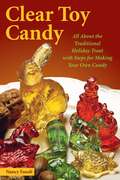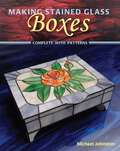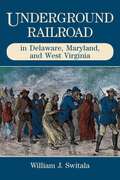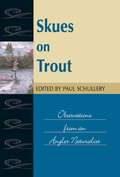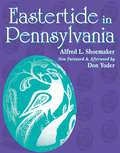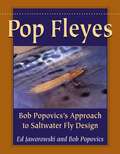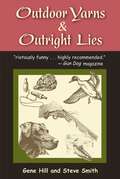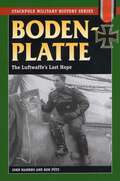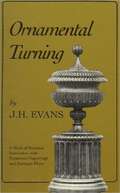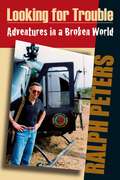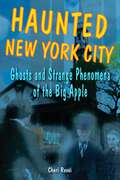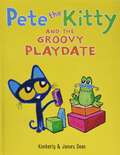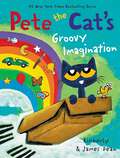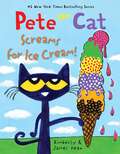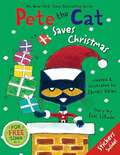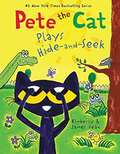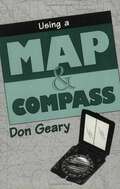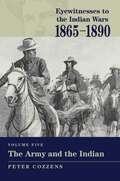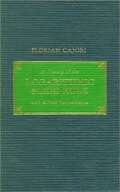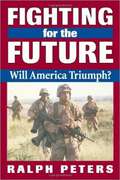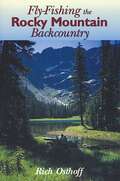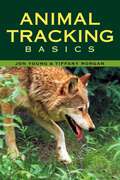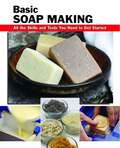- Table View
- List View
Clear Toy Candy
by Nancy FasoltTechniques for making the traditional candy, including ingredients, utensils, and antique molds.
Making Stained Glass Boxes
by Michael JohnstonIllustrated step-by-step instruction on techniques to make a variety of beautiful and practical stained glass boxes. Photos show exactly how to assemble corners, attach hinges and lids, work with mirrored glass, create shelves and compartments, and add feet and lips. Detailed information for the beginner or more experienced glass artist.
Underground Railroad in Delaware, Maryland, and West Virginia (The Underground Railroad)
by William J. SwitalaDetailed maps trace the routes runaway slaves followed. Explores the impact of geography, transportation, free blacks, and members of religious congregations on the Underground Railroad. Information on modern roads and landmarks allows readers to retrace escape paths.
Skues on Trout (Fly Fishing Classics)
by G. E. M. SkuesUseful advice from the father of nymph fishingExtraordinary observations of the trout's worldGeorge Edward MacKenzie Skues has been described not only as the father of nymph fishing but as the greatest fly fisher who ever lived. He was also a modest, humorous, and warmly companionable writer. Both beginners and experts find his work accessible, entertaining, and enormously informative.Skues was that rarest of angling authorities, the iconoclast with a reverential respect for fly-fishing's traditions. A leading student of the sport's history and literature, Skues had a rare gift for sifting through many generations' accumulation of opinion and advice, keeping only what was truly useful and adapting it to the needs of anglers in a rapidly changing world. Skues on Trout showcases one of angling's greatest theorists sharing his hard-won wisdom along his beloved trout streams.
Eastertide in Pennsylvania
by Albert L. Shoemaker• 40th Anniversary EditionFirst published in 1960 and written by a pioneer in American folklife studies, this classic work explores the folk practices surrounding the Easter holidays, from Shrove Tuesday and Ash Wednesday to Easter Sunday and Whitsuntide. Interviews and newspaper reports, from the eighteenth century through the early twentieth century, record the evolution of holiday traditions, including fastnachts, the Easter Rabbit, decorated eggs, and Easter-egg trees. Don Yoder has contributed a new foreword which focuses on the folklife center responsible for this definitive work and an afterword, which examines current research on the holidays.
Pop Fleyes
by Ed Jaworowski Bob Popovics"The most innovative fly tier I have ever known." --Lefty Kreh on Bob Popovics"Bob Popovics has brought more creative ideas to the table in the last two decades than any other tier out there." --Dan BlantonThis is the first and only book available on the tier whose techniques with epoxy and silicone revolutionized saltwater fly tying. The family of flies Bob Popovics developed over the last three decades (dubbed "Pop Fleyes," a spelling that incorporates part of his last name with the fact that eyes are a prominent feature in their design) have proven devastatingly effective for stripers, bluefish, false albacore, and many more species. This book goes beyond the basic recipe format to provide the thinking behind Popovics's pattern development, a guide to key tying techniques, and detailed notes on how to fish Pop Fleyes most effectively.
Outdoor Yarns & Outright Lies
by Steve Smith Gene HillGuaranteed to spark memories of enjoyable time spent afield, this classic collection of stories from well-loved authors Gene Hill and Steve Smith captures the essence and humor of the outdoor life. Whether they're writing about ice fishing, calling ducks, dealing with gunsmiths, or dragging the unwilling dog to the vet, these two wits are sure to entertain. And when it comes to recalling those all-too-abundant missed shots, close calls, and ones that got away, readers might just learn a thing or two about the art of "looking at the truth from a variety of angles," as Gene Hill offers "irrefutable proof that the judgment and memory of the outdoorsman improves, like a fine wine, with time."
Bodenplatte (Stackpole Military History Series)
by John Manrho Ron PutzDefinitive account of the last great Luftwaffe attack of World War II Gripping stories of Fw 190s and Bf 109s in combat Contains hundreds of eyewitness accounts and rare photos In the early morning of January 1, 1945, as the Battle of the Bulge smoldered to an end, the German Luftwaffe--assumed to be starved of fuel and fighting spirit--launched a massive, surprise, low-level strike on Allied airfields throughout France, Belgium, and Holland, an operation code-named Bodenplatte. More than 900 German aircraft took to the skies and attacked the vulnerable fields, destroying 200 Allied aircraft and damaging 150 more. In a pyrrhic victory, the Luftwaffe lost 271 fighters, with many more damaged, and 213 pilots--irreplaceable losses at this stage of the war.
Ornamental Turning: A Work of Practical Instruction in the Above Art ; With Numerous Engravings and Autotype Plates
by John H. EvansEvans, like his contemporaries, the Holtzapffels, was a manufacturer of high quality lathes; but he was also an accomplished turner and, for 33 years, the author of many articles for English Mechanic, a leading journal of the time. His broad combination of engineering and practical experience, along with his literary skills, makes Ornamental Turning one of the most useful books in the field. Clearly written and richly illustrated, with over 190 detailed line drawings and 19 plates, it provides a complete coverage of the subject. Included is information available nowhere else: a chapter on DawsonUs geometric slide rest, details on the design of many types of apparatus, and a brief chapter on electrotyping. This is a complete reprint of the original 1886 edition.
Russell Jennings Manufacturing Company Trade Catalog, 1899
by Kenneth D. RobertsRussell Jennings was synonymous with drill bits and the 1899 catalog showswhy, with its beautifully illustrated and fully described presentation.,
Looking for Trouble
by Ralph PetersRalph Peters--career soldier, controversial strategist, prize-winning, best-selling novelist, erstwhile rock musician, popular columnist, and old-fashioned adventurer--has always been good for a surprise. Now, for the first time, Peters recounts the personal experiences that shaped his views of the world, from the collapsing Soviet Union to the drug wars of the Andean Ridge, from quiet forays into Burma and Laos to military missions to Pakistan and the Caucasus--and on to the Southwest border of the United States and the meanest streets of Los Angeles. As the U.S. Army's chosen troubleshooter before he took off his uniform to write, Peters saw the greatest international dramas of our times and the personal tragedies they created from a truly unique perspective--and took advantage of every moment "outside of the wire." The result is startling: the liveliest adventure memoir by an American in decades, a perfect balance of high drama and laugh-out-loud hilarity. Readers--among them his many devoted fans--will meet a faded beauty and former favorite singer of Josef Stalin's, now in her nineties and still a hopeless coquette; KGB officers who refuse to let go of the past in Moscow's back streets; a winsome princess adrift in a dying world; the corrupt Thai police general whose hobby was imitating Elvis to karaoke machines in rural bordellos; sentimental Caucasian gangsters; oblivious diplomats; wary Burmese colonels; doomed Mexican drug cops; Mennonite marijuana farmers; lonesome Nazi widows in Bolivia--and their Jewish friends; Muslim fundamentalists who write love poetry to imagined sweethearts . . . and, above all, the author's two loyal brothers-in-arms who sometimes shared the dangers and the wonder at the "back of beyond" and whose remarkable personal backgrounds, dashingly eccentric personalities, and appetite for adventure explode every cliché about military officers. Beautifully written and hauntingly told, Looking for Trouble is simply the book Ralph Peters was born to write. We can all be glad that he came back alive to write it.
Haunted New York City (Haunted Series)
by Cheri FarnsworthAmerica's most populated city is also home to bizarre ghosts and frightening creatures of the night.
Pete the Kitty and the Groovy Playdate (Pete The Cat)
by Kimberly Dean James DeanPete the Kitty is excited for a playdate with Grumpy Toad, but his friend won't share any of his cool toys. Feeling sad, Pete suggests they play together, leading Grumpy Toad to realize that hoarding toys is no fun if you're alone. They decide to share everything, turning the frustrating day into a groovy and awesome one, and learning that sharing with friends is what truly rocks.
Pete the Cat’s Groovy Imagination
by Kimberly Dean James DeanWhen a rainy day cancels his beach plans, Pete the Cat discovers that a simple cardboard box holds endless possibilities. Fueled by his groovy imagination, Pete transforms the box into a rocket ship for a trip to the moon, a submarine to explore the ocean, a speedy race car, and even a stage for his rock band. The story celebrates creativity and shows how a change of plans can lead to the most amazing adventures.
Pete the Cat Screams for Ice Cream!
by Kimberly Dean James DeanPete the Cat is racing to meet the ice cream truck, but his journey is interrupted by friends in need. He chooses kindness over his craving, stopping to comfort a lonely Gus, help Grumpy Toad with a flat tire, and clean up a messy park with Callie. Though he fears he's missed his treat, Pete's good deeds are rewarded when the ice cream truck arrives for everyone to enjoy.
Pete the Cat Saves Christmas
by James DeanWhen Santa falls ill on Christmas Eve, he asks Pete the Cat to deliver gifts to children everywhere. Though small, Pete accepts the challenge with courage and cheer. Driving his groovy minibus and helped by reindeer, he gives it his all. With determination and kindness, Pete ensures Christmas is saved and the holiday spirit shines bright.
Pete the Cat Plays Hide-and-Seek
by Kimberly Dean James DeanPete the Cat and his friends play a lively game of hide-and-seek. As the seeker, Pete races around, mistaking objects for his pals, but he never gives up. At first, he feels frustrated, but with patience and a deep breath, Pete finally finds everyone. The story teaches perseverance, observation, and the value of slowing down.
Using a Map & Compass
by Don GearyChoosing and operating a compass, interpreting maps, navigating in the wild, and handling outdoor emergencies.
Eyewitnesses to the Indian Wars: 1865-1890
by Peter Cozzens• Articles by William T. Sherman, James A. Garfield, John Pope, Nelson A. Miles, Elizabeth Custer, and others• Topics include army life on the frontier, Indian scouts, women's experiences, and commanders and their campaignsThis is the final installment of a series that seeks to tell the saga of the military struggle for the American West, using the words of the soldiers, noncombatants, and Native Americans who shaped it. To paint as broad and colorful a picture as possible, riveting firsthand materials have been carefully selected from contemporaneous newspapers, magazines, and unpublished manuscripts. A fitting conclusion to the series, this volume offers a more general perspective on the frontier army and its relationship with the Native American residents of the West.
History of the Logarithmic Slide Rule and Allied Instruments
by Florian CajoriThe slide rule, with its many variations, has been vital to mathematics and engineering since its invention in the 17th century. Interest in this field has grown dramatically and collectors can still find much material at affordable prices. Unfortunately there has been little information available except for manufacturers manuals and catalogs, making this reprint of Cajori's classic particularly valuable. Also included with this reprint of the 1910 edition is Cajori's extensive article On the History of Gunter's Scale and the Slide Rule during the 17th Century, published by the University of California in 1920, which sets forth his subsequent findings. There is also a helpful explanatory introduction by Dr. Robert K. Otnes, editor of the Journal of the Oughtred Society
Fighting for the Future
by Ralph PetersNew introduction reflects upon the events of September 11, 2001 Highly acclaimed military strategist and writer Ralph Peters challenges America's defense establishment and national leadership with startling insights and no-holds-barred criticism. His radical assessment of the future of conflict and the kinds of enemies we will face has already excited international controversy and influenced policy. Peters identifies a 'new warrior class' and a new culture of conflict that could undo America on the battlefields of the future, as seen in the events of September 11, 2001. He broadly reinterprets the meaning of strategy. His writing-tough, yet elegant-makes dramatic new ideas accessible to the general reader, as well as to businessmen, diplomats, and soldiers. Will America Win? Yes, but only if her leaders open their minds to the new and dangerous international environment left in the wake of the Cold War.
Manual of American Engineer's and Surveyor's Instruments
by L. E. Gurley W. GurleyThe manuals published by W. & L.E. Gurley, one of America s leading producers of mathematical and scientific instruments, have been used by generations of engineers and surveyors. In this manual Gurley describes all of its various instruments: how they are calibrated, used and maintained, and includes a catalog of its complete instrument line. This 1874 edition is especially valuable since it is one of the earliest and is rarely found. With an introduction by David C. Garcelon.
Fly-Fishing the Rocky Mountain Backcountry
by Rich OsthoffHow to reach and fish remote waters in Montana, Wyoming, Colorado, Utah, Idaho, and Oregon.
Animal Tracking Basics
by Jon Young Tiffany MorganOffers expert instruction and in-the-field advice for the novice and experienced tracker.
Basic Soap Making (How To Basics)
by Elizabeth LetcavageHundreds of step-by-step, full-color photographs illustrate exactly how to make cold-process soap. Instructions on molding soap, cutting bars, creating original recipes, packaging gifts, and more. Includes a chapter on constructing a soap mold, liner, and cutter at home.
